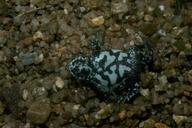|
Distribution and Habitat
Country distribution from AmphibiaWeb's database: Australia
Population and Distribution
Pseudophryne covacevichae is known only from a small area near Ravenshoe, north Queensland were it has been found at 22 discrete sites with 36 populations (McDonald et al. 2000). The species has a limited area of occurrence (approximately 250 km2, map in McDonald et al. 2000) and small area of occupancy (less than 50 ha, McDonald et al. 2000). All records of the species have been from above 800 m altitude (McDonald et al. 2000). Limited information is available on population size, however known populations cover small areas (largest being approximately 0.5 ha, but most less than 0.1 ha) and the number of calling males at each site ranges from 1-20 (McDonald et al. 2000).Pseudophryne covacevichae is known from Timber Reserve 245, SF 754,488, and 251, Millstream NP and Ravenshoe rubbish dump reserve, road reserves and freehold land (Ingram & Corben 1994; McDonald et al. 2000). Habitat
Pseudophryne covacevichae appears to be restricted to specific habitats with all records being from the rhyolites of the Glen Gorden Volcanics (McDonald et al. 2000). The species has been found around seepage areas in open eucalypt forests with an understorey comprised of Themeda triandra, Xanthorrhoea sp., Gahnia sp., Lophostemon suaveolens, Allocasuarina littoralis and A. torulosa (McDonald et al. 2000). In areas where cattle grazing has reduced ground cover the species has also been located in leaf-litter build up in first order streams (McDonald et al. 2000). Non breeding habitat is unknown. Life History, Abundance, Activity, and Special Behaviors
Reproduction
Pseudophryne covacevichae generally calls from seepage areas at the base of grass tussocks on wet summer and autumn nights (McDonald et al. 2000). Pseudophryne covacevichae is primarily nocturnal but may also call on overcast days (McDonald et al. 2000). The call is very similar to the winter breeding Pseudophryne major, from s. and central Queensland (Ingram & Corben 1994). 6-82 eggs are laid on moist soil in or near a seepage, usually under vegetation (McDonald et al. 2000). Observations suggest that the development of eggs pauses prior to hatching (McDonald et al. 2000). After hatching, the tadpole makes its way down the seepage or is washed into first order streams where development continues in small pools (McDonald et al. 2000). Feeding
The diet of the species is unknown but is likely to consist of small ground-dwelling arthropods (McDonald et al. 2000). Trends and Threats
Habitat loss and degradation appear to be the greatest threats to P. covacevichae. Its habitat occurs on land under a variety of tenures, including national parks, state forests, local government reserves, grazing leasehold properties, crown land, freehold lands and road reserves. Ninety-seven percent of frog sites are located on unprotected land, most of which is in state forest or timber reserve. There are several activities likely to occur on these lands which may impact on the amount and quality of the frog’s habitat, including grazing, logging, road works, clearing and development. Habitat in the s.e. of Timber Reserve 245 and Tumoulin SF has been severely affected by cattle grazing. Grazing and trampling has the potential to degrade and destroy the seepage areas used by the frogs for breeding. Similarly, erosion and subsequent siltation may cover seepage areas if future logging or clearing occurs. Roads and cuttings can alter the water quality and hydrology and may affect seepage areas and first order streams. Regrowth forest uses more water than old growth and therefore have the potential to reduce seepages. The population at the Ravenshoe rubbish dump has declined. Dump activities have destroyed or modified habitat, and previously known populations are now absent.[McDonald et al. 2000] Comments
Ingram, G.J. & C.J. Corben 1994. Two new species of broodfrogs (Pseudophryne) from Queensland. Memoirs of the Queensland Museum 37: 267-272. [Journal; Status=Final; Refereed=Yes] McDonald, K.R., E. Bolitho, A. Dennis, N. Simpson & J.W. Winter 2000. Recovery plan for the Magnificent Broodfrog Pseudophryne covacevichae 2000-2004. Unpublished report to Environment Australia, Canberra. [State Recovery Plan; Status=Final; Refereed=?] Contributors
J-M. Hero; L. Shoo; M. Stoneham
Originally submitted by: Jean-Marc Hero et. al. (first posted 2002-04-05)
Edited by: Ambika Sopory, Jean-Marc Hero (2002-05-04)Species Account Citation: AmphibiaWeb 2002 Pseudophryne covacevichae: Magnificent Brood Frog <https://amphibiaweb.org/species/3586> University of California, Berkeley, CA, USA. Accessed Jan 14, 2025.
Feedback or comments about this page.
Citation: AmphibiaWeb. 2025. <https://amphibiaweb.org> University of California, Berkeley, CA, USA. Accessed 14 Jan 2025.
AmphibiaWeb's policy on data use.
|



 Map of Life
Map of Life